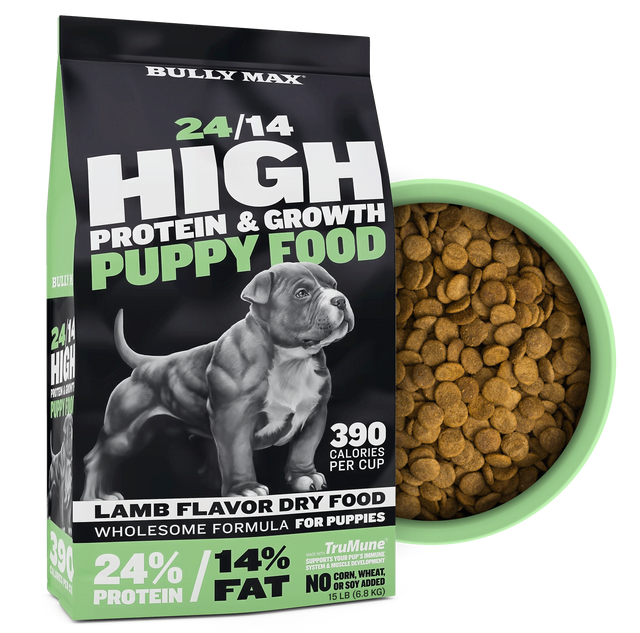How to Fatten Up a Dog? [Dog Trainer Explains]
Have you noticed that your dog seems a little thinner than usual? While we don’t want our dogs to be overweight, being underweight can be just as concerning. If you notice your dog is losing weight, you’ll need to know how to fatten up a dog to get him back to a healthy weight. Fattening up a dog isn't always as simple as feeding more. There may be underlying health reasons why your dog has lost weight. Some dogs might need more food because they are exercising more, or they could have an underlying health condition causing the weight loss. Before making significant changes to a dog’s diet or lifestyle always consult with your dog’s veterinarian.
Why Is My Dog Underweight?
While some dogs can be naturally thin, being underweight can often be a sign of an underlying health condition. There can be serious health reasons why dogs are underweight including cancer or diabetes. Less serious reasons dogs might struggle to gain or keep weight on include internal parasites, dietary issues, stress, or allergies. Your vet will be able to examine your dog and determine if there is a health reason for the weight loss. Once health issues are ruled out, your vet can help you find ways to fatten up your dog to healthy weight.

How to Tell if a Dog is Healthy Weight?
It’s important to keep dogs at a healthy weight for their overall health at all stages of life. The right weight for your dog is going to be determined by their size, breed, age, activity level, and muscle tone. To see if your dog is overweight we recommend to use our dog weight chart to determine your dogs' ideal weight. We also recomment to have a conversation with your dog’s veterinarian. They will be able to look at your dog’s health holistically, and will consider muscle tone, overall condition, and level of physical fitness, not just a number on a scale.
Your dog’s veterinarian will also be able to show you how to identify what a healthy weight for your dog should be. If your dog is a healthy weight you should be able to feel your dog's ribs. However, their ribs shouldn't be visible. If your dog’s ribs are visible, talk with your vet for advice about how to support your underweight dog. A dog who is a healthy weight will have an hourglass-shaped figure (tucked waist) when looked at from above.

How to Fatten Up a Dog: High-Quality Foods and Supplements
All dogs need and deserve to eat high-quality dog food. The best dog food for weight gain is a food like Bully Max made with quality proteins, healthy fats, and carbohydrates. These dog food ingredients help dogs gain weight, develop and maintain healthy muscle tone. High-quality dog food is rich in nutrients, and avoids the kind of fillers that don't support a dog's overall health. Some people will suggest giving dogs supplements or human food additives into their diet. These might include peanut butter, pumpkin, and sweet potatoes to bulk up a dog’s meal. These human foods are safe in moderation. But, if you're going to feed human food regularly, speak with your dog’s veterinarian. Your vet will let you know what amount is safe for your dog. Your veterinarian will also give guidance on what nutritional supplements might be appropriate for weight gain.
Effective Feeding Techniques to Boost Weight Gain in Dogs
It's best to feed dogs multiple smaller meals instead of fewer large meals. This is true for all dogs, and especially those who need to gain weight. By feeding your dog more frequently you can improve your dog’s digestion. Small meals can also increase a dog's desire to eat. Smaller meals spread out during the day also help prevent bloat. Bloat is the common name of Gastric Dilatation-Volvulus or Gastric Torsion. This is a condition where a dog's stomach fills with food or gas and twists on itself. Bloat can be fatal without emergency treatment.
If you have a dog who is struggling with gaining weight you may need to change your feeding techniques. Changing how you feed can increase your dog’s appetite. An option to get more food into high-drive working dogs is to use their meals as training rewards. Some dogs get bored easily with bowls. These dogs often do better with hand feeding food as a training reward. Feed your dog their meal practicing basic obedience skills, or learning new tricks. By hand feeding your dog their meals you may be able to stimulate your dog’s appetite and interest in food. Another option is to feed your dog in food puzzles and snuffle mats. These can be stuffed with your dog's food and given to your dog as an enrichment activity. Some dogs like the challenge of having to "work" for their food and can encourage reluctant eaters.
The Best Dog Foods and Homemade Meals for Weight Gain
All dogs deserve high-quality food. Bully Max dog food is uniquely formulated to provide dogs of all ages, breeds, and sizes with optimal levels of the nutrition they need. With meat meal as the primary ingredient, this high-protein diet helps dogs build muscle. Designed specifically with athletic and working dogs in mind, Bully Max helps to keep weight on these strong and active dogs. Quality dog food is the easiest way to feed dogs and help them gain and maintain weight.
If you want to prepare homemade meals for your dog it’s important the food is calorie-dense, with all the nutrients that your dog needs. The best way to create homemade dog meals for weight gain is to work with a board-certified veterinary nutritionist. A veterinary nutritionist will be able to develop a cooking plan to create meals that meet your dog’s individual dietary needs.
Tracking and Adjusting Your Dog’s Diet for Optimal Weight Gain
If you have a dog who is struggling to gain weight it’s important to track and monitor your dog's eating. You'll want to track your dog’s food intake as well as food and weight trends over time. This information can help you to notice any kinds of trends over time. The easiest way to track diet over time is to keep a food journal for your dog. In the journal, you can document the type and t quantity of food you are feeding. Make note of how much food your dog eats, as well as what you notice with your dog’s eating preferences. You'll also want to document any weight changes or other health changes. You can then reference this food journal to adjust your dog's diet and meal plans based on progress, preferences, and health changes.
Overcoming Behavioral Eating Issues in Dogs
If your dog’s veterinarian has ruled out health reasons for your dog being underweight, the issue might be behavioral. Some dogs don’t have a lot of interest in food, or they may be struggling with mealtime anxiety. If your dog is experiencing anxiety around mealtime they are going to be less likely to eat. For these dogs we want to focus on creating a stress-free eating environment. Try to make mealtime as calm and safe as possible. Anxious dogs benefit from having quiet places to eat. This might look like eating in a crate, or in a quiet room without distractions. This can help your dog focus on their meal and not on what is happening around them. Quiet and private mealtimes also helps dogs worry less that someone (person or other animal in the home) will bother them and try to get their food. By reducing anxiety around mealtime your dog may have an easier time eating. If your dog is an anxious eater, you may need to trial a couple different feeding approaches to figure out what works best for your dog.
Balancing Exercise with Nutrition for Healthy Dog Weight Gain
Weight gain and maintenance can be a challenge for high-energy dogs. Exercise for all dogs is important, and active dogs are going to have different nutritional needs than dogs who live more sedentary lives. However, for dogs who struggle to maintain weight, a lot of exercise can cause them to drop weight quickly. If you have an underweight dog, talk with your dog’s veterinarian about what appropriate levels of exercise are in your dog’s current condition. Exercise combined with balanced nutrition should support a dog building muscle while they gain weight.
Consulting a Veterinarian: When Your Dog’s Weight Gain Needs Professional Insight
If your dog is medically underweight they should be examined right away by a veterinarian as that could be a sign of parasites or a more serious health condition that needs treatment. Anytime a dog is struggling to gain or maintain weight it’s always appropriate to schedule an appointment with a veterinarian. Let the clinic know that you need a vet consultation for dog weight gain, which will give your vet the opportunity to examine your dog’s overall health. Your vet will explore if there are health reasons that your dog is struggling to gain weight. If there is a medical condition behind why your dog can’t gain or maintain weight then no amount of feeding will be able to increase their weight until the health condition is addressed.
Conclusion
It can be stressful and frustrating to have a dog who isn’t gaining weight. If you are struggling with keeping weight on your dog your first stop should be an appointment with your dog’s veterinarian. Keep close track of how much your dog eats. Pay attention to trends with what food your dog eats as well as weight gain and loss. Many people have ideas about canine diets, but the best resource is going to be your dog’s veterinarian, or a board-certified veterinary nutritionist. We recommend to explore dog health and nutrition resource from The American Animal Hospital Association AAHA Nutritional Resources.









